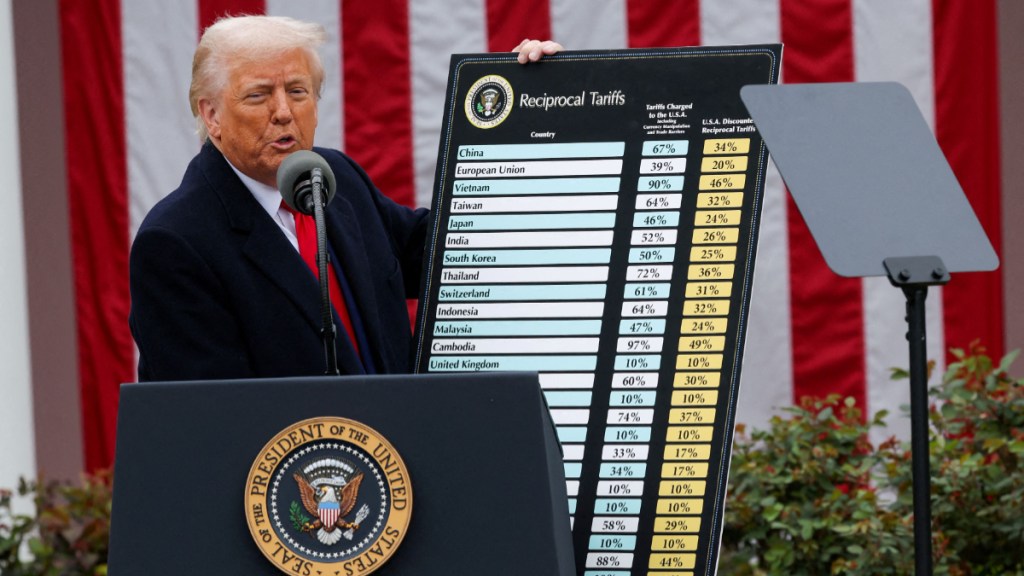US President Donald Trump’s imposition of a blanket 26 per cent tariff on imports from India has sent ripples across various industries. While the decision is expected to disrupt several key sectors in India, some might find advantages. India’s primary exports to the US include pharmaceuticals, telecom equipment, gemstones, petroleum products, gold jewellery, and ready-made cotton garments. On the import side, key commodities include crude oil, coal, petroleum products, electric machinery, and aerospace components.
According to a New York Times report, the White House officials explained that the tariff figures were calculated by the Council of Economic Advisers using established methods. The White House clarified how the calculations were done. Although the explanation involved some complex calculations, the report stated that the formula is derived from the US trade deficit with a country, divided by that country’s exports. However, it cannot be considered as foolproof and there are many loopholes. For e.g, the calculations include non-tariff measures like domestic taxes (strange, since it’s not differentiating to foreign goods) and currency manipulation.”
Key sectors to be impacted by US tariff
Among the worst affected by the recent tariff hike are India’s electronics and gems and jewellery sectors. The US imports nearly $14 billion worth of electronics and over $9 billion worth of gems and jewellery from India. Meanwhile, the pharmaceutical sector, semiconductors, and critical minerals have been excluded from these tariffs.
Dr Manoranjan Sharma, Chief Economist at Infomerics Rating, said, “President Trump’s imposition of a 26 per cent reciprocal tariff on India would hit India’s exports by 3 to 3.5 per cent and GDP growth in FY26 by 40-60 bps. At the sectoral level, nearly $14 billion worth of electronics products and over $9 billion worth of gems and jewellery would be dented. While the 26 per cent tariff is inapplicable to auto parts and aluminium products, those will still attract the 25 per cent tariff announced earlier.”
Here is a look at how various sectors are or will be impacted by Trump’s tariff:
Electronics industry: India’s electronics exports to the US are worth $14 billion and the increased tariffs may lead to higher prices, reducing demand from American buyers. Ashok Chandak, President of IESA, said, “Tariffs may impact India’s booming exports, but India could remain competitive as China, Vietnam, Taiwan and Thailand face even higher tariffs. India’s low electronics imports from the US provide room for tariff adjustments to maintain trade balance.”
Pharmaceutical industry: Donald Trump has exempted pharmaceuticals from his reciprocal tariff plan. However, experts warn that the relief may be short-lived. Tausif Shaikh, India Analyst – Pharma and Healthcare, BNP Paribas , said, “Assuming a 10 per cent tariff is imposed on pharma products, we expect the impact to be negligible. With the sector exempted from reciprocal tariffs currently, we expect a relief rally for the Nifty Pharma Index, after its 11 per cent YTD decline.”
Automobile industry: Donald Trump announced a 26 per cent reciprocal tariff on India, but this does not include the automobile sector including the OEMs and component industry. Indian auto players will only face the 25 per cent tariffs that were earlier announced. Mrunmayee Jogalekar, Auto and FMCG Research Analyst, Asit C Mehta Investment Intermediates Ltd, said, “For the Indian auto component industry, which derives around 30 per cent of its revenue from exports, with 30 per cent of that coming from the US, this could result in a potential hit on sales or profit margins.” The US is a $7 billion export market for Indian auto component manufacturers. “The 25 per cent tariff on automobiles and components could exacerbate the congestion for our exporters competing with Vietnamese and Mexican counterparts. These players may lose anywhere between 8-12 per cent of their margins,” said Sankar Chakraborti, MD & CEO, Acuité Ratings and Research Ltd.
Gems & Jewellery industry: India exports $9 billion worth of gems and jewellery to the US and the higher tariff is expected to raise prices, making Indian jewellery less competitive. This could lead to a decline in exports and impact employment in the sector. On this, the Gem and Jewellery Export Promotion Council (GJEPC) urged the government of India to progress the Bilateral Trade Agreement between India and the US, as it would be crucial in navigating the tariff issues and securing long term interest of the sector. Bilateral trade between India and the US includes natural and lab grown polished diamonds, gold and platinum jewellery, silver jewellery, imitation jewellery, rough diamonds, rough LGD, rough coloured gemstones, gold bar, silver bar and platinum bar, coloured gemstones. Paresh Parekh, Partner and Retail Tax Leader, EY India, said, “Indian gems and jewellery sector has been already struggling since the last few years due to changing customer preferences, lab grown diamond technology, demonetization, soaring gold prices, and competition for polishing from other countries. The US Tariff developments now create additional adverse impact on the sector, with real risk of job losses and margin erosion.”
Textiles and apparel industry: The U.S. is a major market for Indian textiles, with exports worth $9.6 billion. According to analysts, while the increased tariff is likely to impact exports, it also gives India’s textile industry an advantage as its competitors like Vietnam, Bangladesh and China will face higher tariffs. Manish Jain, Chief Strategy Officer & Director, Mirae Asset Capital Markets, said, “India will have two-way impact of these reciprocal tariffs, 1st higher tariff on competing nations to support market share gains as China, Bangladesh and Vietnam are levied at much higher rate of 34 per cent, 47 per cent and 46 per cent respectively compared to 26 per cent on India. Secondly, the increase in prices to end consumers will reduce the overall demand, shrinking the market size.”

